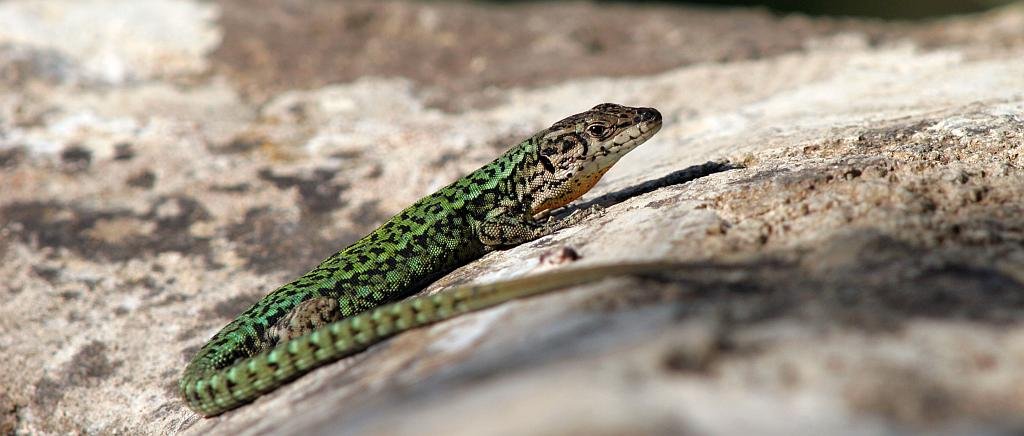- English: Andalusian Wall Lizard
- Scientific: Podarcis vaucheri
- Spanish: Lagartija andaluza
- French: Lézard Andalouse
- German: Andalusischen Mauereidechse
- Italian: Lucertola Andalusa
- Portuguese: Lagartixa-andaluz
- Distribution: southern Spain (Western Andalucia), central and northern Morocco, northern Algeria and northern Tunisia.
- Similar species: Iberian wall lizard (Podarcis hispanicus) Lagartija ibérica (Basically if you are anywhere other than Western Andalucia its probably an Iberian wall lizard….) – Spanish Psammodromus (Psammodromus hispanicus) lives in open terrain and does not climb – Large Psammodromus (Psammodromus algirus) has 4 well defined darker stripes and much longer tail.

The Andalucian wall lizard – Podarcis vaucheri – Lagartija andaluza is a small, slender lizard with a somewhat flattened head and body. Their body length is between 4 and 6 cm (1½ to 2½inches). The tail can be more than twice the body length, bringing the total length to18 cm in the larger examples (7 inches). The males are the larger and more robust, with voluminous head and longer limbs. They display a wide variety of colours, the background can be brown, grey or green. The dorsal pattern of the males is usually green and brown with black spots forming broken or irregular lines. The females usually have more defined stripes.
Active throughout the year except during the coldest winter days they prefer habitas with platforms where they can sunbathe with close access to shelters, to hide in case of danger. They like to live in stony and rocky areas, old walls, buildings, tree trunks, etc.
Food consists of small insects, spiders, millipedes and gastropods.

Breeding can start from late February and lasts until July. During this period, the males engage in fights, after which the winner mates with the female. They can produce up to 4 clutches of eggs per year. 1-5 eggs per clutch are laid which take 48 to 82 days to hatch. At birth they have a brown dorsal colour often with a blue or green tail.

This species was formally treated as a subspecies of Podarcis hispanicus, (See below) but rose to the rank of species (Oliver et al. 2000) and was originally considered to only be in northern Africa, but has also been shown to be present in southern Spain (Harris et al. 2002).
The Iberian wall lizard – Podarcis hispanicus – Lagartija ibérica
To be honest, I can’t tell the difference between these two lizard species and some studies even point to interbreeding along the distribution frontiers.
Identification by geographic location is the key… basically, anywhere between Malaga along the coast towards Cádiz and then the Portuguese border and inland to the Sierra Norte de Seville and back towards Jaen seem to be the territory of the Andalucian wall lizard….. Anywhere else its the Iberian wall lizard…. (Any comments and corrections are most welcome)

There is also a subspecies of the Iberian wall lizard, Podarcis hispanica atrata that lives in the Columbretes Islands off the eastern coast of Spain on the way to the Balearics. See wikipedia article in Spanish here.
Iberia Nature Forum
Struggling with identifying those bugs and beasties? Why not check out the Iberia nature Forum!
Discover the Iberia Nature Forum – Environment, geography, nature, landscape, climate, culture, history, rural tourism and travel.
I’ve been living in this lovely area of Western Andalucia for the last 20 years or so and dedicate most of my time to the running of English language tourist information websites for the towns of Cádiz, Ronda, Grazalema, the famous or infamous Caminito del Rey, and also Wildside Holidays, which promotes sustainable and eco-friendly businesses running wildlife and walking holidays in Spain. My articles contain affiliate links that will help you reserve a hotel, bus, train or activity in the area. You don’t pay more, but by using them you do support this website. Thankyou!
